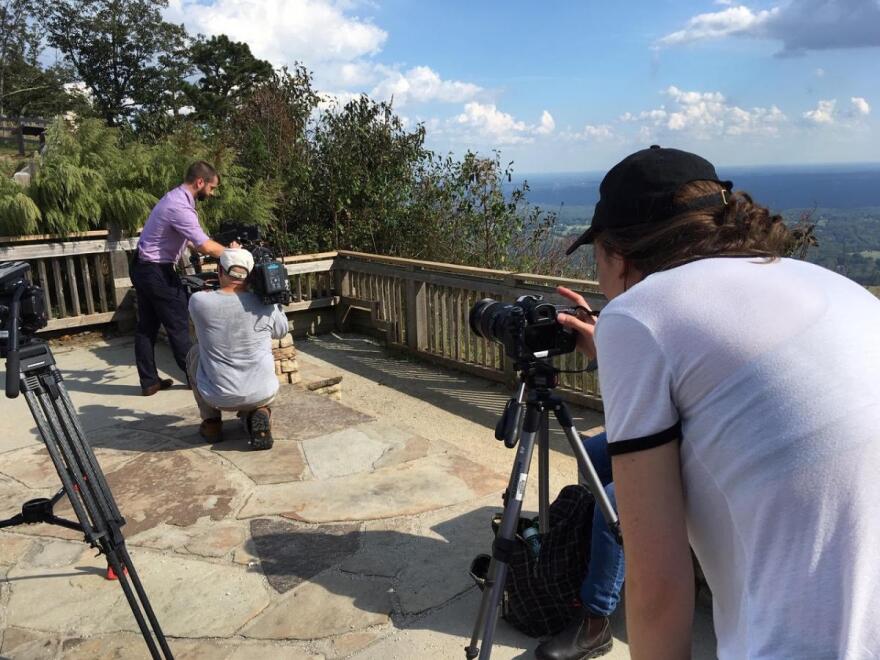Looking at black and white nighttime film footage taken by thermal cameras mounted on drones, a group of four bright white dots stand out like little oval-shaped stars against the greyish backdrop. Each dot is a deer given away in the cover of darkness by its body heat.
Pilot Mountain Has A Deer Problem. Drones Can Help, a university-led documentary with a Piedmont focus, stars deer and drones. The production is a collaboration between the University of North Carolina at Chapel Hill, Wake Forest University, and UNC-TV.
The small, unmanned aircraft are often flown for recreation. But as the technology evolves, new uses are being discovered every year, from aerial construction to wildlife conservation. In Surry County, students and researchers have been busy flying and filming to map deer populations.
The goal? Protect native plant species from excessive grazing at Pilot Mountain State Park.
Professor Tom Linden teaches environmental documentary filmmaking at UNC-Chapel Hill.
“We had a drone from UNC-TV that was tracking the Wake Forest drone," says Linden. "So, we had video of the Wake Forest drone looking down below. And then we had video from our drone shooting the other drone shooting down below. And then we had another camera on the ground shooting video of the two drones. It was a lot of fun and very challenging.”

Linden says his students were tasked to create a video story about an environmental challenge. His hope is that it will keep people's attention focused on these issues and the role humans play. In the case of Pilot Mountain, too many deer are eating too much vegetation.
“The state parks are a protected area, so there's no predation of the deer taking place," he says. "And without a story like this being told, people may not be aware of how threatened our environment is and how important it is to try and keep the numbers of our indigenous species of plants and animals in balance.”
And when that balance gets out of whack, it may never recover, says Wake Forest Research Fellow Jared Beaver.
“Pilot Mountain actually used to be a place to come to see kind of rare wild flowers," says Beaver. "There used to be a lot of trillium species and a lot of different diversification in the understory as far as wild flowers go and basically what we've seen is anything that's edible to a deer is gone.”
Park officials have implemented various management strategies, like thinning the herd and prescribed fire. But Beaver says they need accurate deer counts to best move forward. They began by placing dozens of motion detecting camera traps throughout the park. That took too much time. Plus, battery and memory card replacement dragged out the data collection process for months.
Then came the switch to drones.
“And so what the drones allow us to do is go in and do an imaging campaign of three or four days with the drone flying from a centralized location and get an estimate that way," says Max Messinger, Director of Wake Forest University's Unmanned Systems Lab. "So, it's faster and more cost-effective.”
Even this impressive technology comes with limitations. These specialized cameras cannot see through tree canopy, so the leaves have to be off. Plus, in order to register as a distinct image, the deer need to be significantly warmer than the background, which means filming only during winter months. Messinger says even the time of day is crucial.
“We have to do it right at dawn and dusk. And at Pilot Mountain, we've actually found that dawn is the best time because as the sun heats up throughout the day, it becomes harder and harder to see the animals.”
But even with those limitations, there are safety benefits: manned aircraft, like helicopters, are the number one related cause of death for active wildlife biologists during duty. And the accuracy of this technology is tested and proven at up to 95%.
That's encouraging to Jared Beaver.
“One of the things we know is this is emerging technology so it's only going to get better. The sensors are only going to improve. Our method of delivery with drones is only going to improve, and so, this technology is here.”
It's a less rosy picture for the hundreds of deer who currently call Pilot Mountain State Park home. The area typically supports 10-20 deer per square mile, but current counts are up to 80. And it shows in the landscape. Today the park is virtually devoid of small plants and shrubs that indicate a healthy forest. They've all been eaten. The overpopulation also shows in the animals themselves.
“There's only a certain period of time that those deer can sustain those numbers before we see a dramatic die off because those deer are going to die," says Beaver. "It's a matter of whether we do it humanely, or we see a massive starvation or a widespread disease outbreak because these deer are not healthy enough to fight off disease.”
To prevent the massive die-offs, and ultimately to increase plant diversity here, Beaver says they're looking at up to a 50% herd reduction carried out by park personnel.
“Pilot Mountain has a deer problem. Drones can help,” airs April 4th on UNC-TV.

